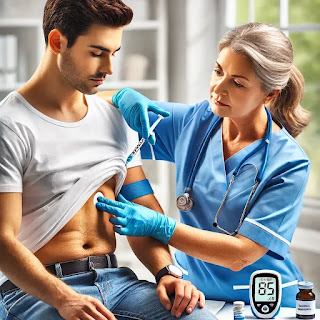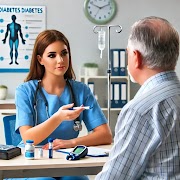ตัวอย่างข้อสอบ Diabetes Mellitus NCLEX
NCLEX Practice Questions on Diabetes Mellitus
1. A client with type 1 diabetes mellitus is found unconscious at home. What is the priority nursing action?
a) Administer glucagon subcutaneously
b) Check the client’s blood glucose level
c) Call 911
d) Administer rapid-acting insulin
2. Which symptom is most characteristic of diabetic ketoacidosis (DKA)?
a) Cold, clammy skin
b) Fruity breath odor
c) Slow, shallow respirations
d) Decreased thirst
3. A client with type 2 diabetes asks how exercise helps manage blood glucose levels. What is the best nurse response?
a) “Exercise decreases the amount of insulin needed.”
b) “Exercise increases blood sugar levels by releasing stored glucose.”
c) “Exercise reduces the effectiveness of insulin in the body.”
d) “Exercise has little effect on blood sugar control.”
4. The nurse is teaching a newly diagnosed type 1 diabetic client about insulin injections. Which statement by the client indicates a need for further teaching?
a) “I will rotate injection sites to prevent lipodystrophy.”
b) “I should inject insulin into my muscle for faster absorption.”
c) “If I skip a meal, I might need to adjust my insulin dose.”
d) “I will monitor my blood sugar levels before and after exercise.”
5. Which laboratory value best indicates long-term blood glucose control?
a) Fasting blood glucose
b) Random blood glucose
c) Hemoglobin A1C
d) Urine glucose test
6. A client with type 1 diabetes reports nausea and vomiting for the past 24 hours. What should the nurse instruct the client to do?
a) “Stop taking insulin until you can eat.”
b) “Increase your insulin dose to prevent DKA.”
c) “Monitor your blood sugar and drink fluids.”
d) “Take only rapid-acting insulin.”
7. A diabetic client is admitted with confusion, sweating, and tremors. What is the most likely cause?
a) Hyperglycemia
b) Hypoglycemia
c) Diabetic ketoacidosis
d) Hyperosmolar hyperglycemic state
8. The nurse is teaching a client with type 2 diabetes about meal planning. Which food choice shows correct understanding?
a) White bread with jam
b) Grilled chicken with quinoa and steamed broccoli
c) Fried chicken with mashed potatoes
d) Sweetened fruit yogurt and orange juice
9. A client taking metformin is scheduled for a CT scan with contrast. What is the most important nursing action?
a) Administer extra fluids before the test
b) Hold metformin before and after the test
c) Check blood glucose every hour
d) Encourage a high-protein meal
10. Which statement by a diabetic client indicates a need for further teaching?
a) “I will avoid alcohol because it can cause low blood sugar.”
b) “I should eat a small snack before exercising.”
c) “I can reuse my insulin syringes if I clean them well.”
d) “I will check my feet daily for cuts or sores.”
1. Answer: a) Administer glucagon subcutaneously
Rationale: The client is likely experiencing severe hypoglycemia, which can lead to coma or death. Administering glucagon will help raise blood sugar levels. If the client does not respond, emergency services should be contacted.
2. Answer: b) Fruity breath odor
**Rationale:** **DKA** occurs due to **ketone accumulation**, leading to **fruity-smelling breath**. Other signs include **Kussmaul respirations (deep, rapid breathing), dehydration, and hyperglycemia**
3. Answer: a) “Exercise decreases the amount of insulin needed.”
**Rationale:** Exercise **enhances insulin sensitivity**, allowing glucose to be used more efficiently and reducing the need for additional insulin.
4. Answer: b) “I should inject insulin into my muscle for faster absorption.”
**Rationale:** **Insulin should be injected into subcutaneous tissue**, not muscle, to ensure **steady absorption and prevent unpredictable effects**.
5. Answer: c) Hemoglobin A1C
**Rationale:** **HbA1C** reflects **average blood glucose levels over the past 2–3 months**, making it the best indicator for long-term diabetes management.
6. Answer: c) “Monitor your blood sugar and drink fluids.”
**Rationale:** **Illness can increase blood sugar levels**, even if the client is not eating. Monitoring blood glucose and staying hydrated can help prevent **dehydration and DKA**.
7. Answer: b) Hypoglycemia
**Rationale:** **Symptoms of hypoglycemia** include **confusion, diaphoresis (sweating), tremors, tachycardia, and hunger**. It requires **immediate intervention** with glucose administration.
8. Answer: b) Grilled chicken with quinoa and steamed broccoli
**Rationale:** The best choice includes **lean protein, fiber, and whole grains** to help stabilize blood sugar levels.
9. Answer: b) Hold metformin before and after the test
**Rationale:** **Metformin + contrast dye increases the risk of lactic acidosis.** It should be held **24-48 hours before and after the procedure** until kidney function is reassessed.
10. Answer: c) “I can reuse my insulin syringes if I clean them well.”
**Rationale:** **Insulin syringes should not be reused** due to the risk of **infection and needle dullness**.





0 Comments